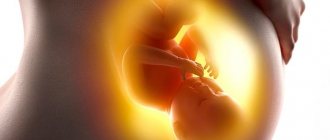How to find out the exact date of birth?
The onset of this day of Miracle depends on many different factors, which are not always possible to take into account. Therefore, it is almost impossible to find out the exact date of birth of the baby, but calculating the expected date of birth is quite easy.
But often many expectant mothers do this incorrectly, adding 9 months to the day of conception. This method of finding out the exact date of birth is not entirely correct. The fact is that the normal duration of pregnancy is not exactly 9 months, but 10 lunar months, or more specifically, 280 days. The expected date of birth during pregnancy is calculated with varying degrees of reliability in several of the most common, most reliable and easiest ways:
- 1. by estimated date of conception;
- 2. on the day of the last menstruation;
- 3. according to ultrasound results;
- 4. based on the results of a gynecological examination;
- 5. at the beginning of the baby’s movements;
- 6. and other signs of intrauterine life.
Top
The most modern method
There is another method that allows you to determine the so-called day “X”. Experts call it the most modern method, since it has been used in practice for less than three years. Its essence is almost the same as in the previous method.
First you need to go to the pharmacy and buy an electronic test. After which you need to do a simple procedure: pour a small amount of urine into a container and dip the device in it for a few seconds.
After some time, the result of the study will appear on the screen, namely the presence and estimated duration of pregnancy. Based on these data, you can independently calculate the due date. The reliability of the analysis and test method is approximately the same.
Estimated due date based on date of conception
One simple way to determine is the expected date of birth based on the date of conception. The female body, as we know, is capable of conception exclusively during the period of ovulation - the period when a mature egg is released from the ovary. Her lifespan is only one day, which means you can get pregnant on a certain day of the month (provided there are no health problems or hormonal imbalances - otherwise ovulation may occur at the wrong time or twice in a month). If you know the date of your ovulation, you can easily predict the date of your upcoming birth.
On average, the duration of the female menstrual cycle is 28-35 days. The onset of ovulation occurs approximately in the middle of the menstrual cycle. To be more precise, with a 28-day cycle, the moment of complete “combat readiness” of the egg will occur somewhere on the 12th day, and with a 35-day cycle, ovulation occurs approximately on the 17th day. Some women feel their own ovulation. The fact is that from cycle to cycle some sensations are repeated, and if you are attentive, you can draw the appropriate conclusions from this. Common signs of fertile days include:
- 1. pain in the area of one of the ovaries or lower abdomen,
- 2. a sharp increase in sexual appetite,
- 3. copious vaginal discharge. Such discharges are qualitatively different from the symptoms of any infectious diseases: they are transparent, odorless and disappear without a trace after 2-3 days.
Ovulation can be accurately determined by ultrasound. You probably clearly know the time of conception if you prepared for it for a long time, kept a temperature diary, and filled out a chart of changes in basal temperature for a long time.
Knowing the day of conception, simply add 280-282 days to it and get the expected date of birth - EDA.
If it happens that the day of conception is unknown to you, then simply calculate the middle of your own menstrual cycle in the month the baby was conceived and add 280 days to this date. In this case, the date will be even more “supposed”, approximate. For example, you can make the following calculations:
- 1. With a menstrual cycle lasting 28 days, your ovulation occurred somewhere between the 12th and 14th day of the cycle.
- 2. Now add 10 lunar months to this day of expected conception, simply 280 days - this day is the approximate date of birth.
Knowing the date of sexual intercourse will help make the task easier and increase the reliability of calculations, especially if sexual intercourse was a single act in the last menstrual cycle. It should be taken into account that the date of conception and the day of sexual intercourse may not coincide. The fact is that sperm can “live” in a woman’s body for several days, on average 3 days. Accordingly, if sexual intercourse took place on the 10th day of your monthly cycle, then ovulation and conception could well have happened on the 12-13th day. You already know how to further calculate the maximum allowance.
Top
Childbirth through the eyes of a child
How does a baby know when it's time to be born?
It is believed that it is the child who contributes to the onset of labor. He does this unconsciously, obeying instinct. And what nature tells him turns out to be enough for the normal course of childbirth. The love hormone, oxytocin, produced in the mother’s body, calms the baby, helping him survive the transition from intrauterine existence to earthly life. Birth is a huge stress for a child. However, don't worry. Mother Nature has already prepared the baby for this important moment, so he will definitely cope with these physical and emotional experiences.
How does a baby feel contractions?
Experts agree that the baby does not experience pain during contractions, although he does feel some discomfort. For him, it's more like a tight hug. Remember when you wanted to crawl into something narrow, for example, through a hole in a fence. The fetus feels something similar during contractions. The supply of oxygen through the placenta is reduced, which acts as a sedative on him. When the cervix dilates, the baby may be in a trance-like state or may simply fall asleep.
What does a child see and hear during childbirth?
Unfortunately, this issue has not yet been studied. Although we know that the baby hears and even recognizes the voices of the mother and those around her, doctors do not know what the baby hears during childbirth. Immediately after birth, a newborn sees almost nothing - his eyes perceive only the blurry outlines of the people and objects around him. Although at a short distance (from the chest to the mother’s face), the baby already sees better. This is important for establishing the first and most important contact at this stage of a child’s life - contact with his mother.
How does a baby breathe during labor?
Before being born, the baby receives oxygen through the placenta, because its lungs are filled with fluid until the first cry. During childbirth, fluid begins to leave the lungs, the respiratory organs expand, the placenta no longer performs its function, the pressure decreases and the baby's lungs begin to be supplied with blood.
How is the fetus progressing?
Just before birth, the baby descends into the entrance to the pelvis. Later, with contractions of the uterus, the baby moves along the birth canal. He presses his head to his chest to fit into the narrower part of the pelvis. Then he turns to face his mother’s spine. If at the beginning of labor the baby has not taken the correct position, the midwife may ask the woman to walk around so that the baby turns over as it should. If this does not happen, the mother’s pain may increase.
When the head appears, the baby stretches his neck. Then he turns slightly, sometimes with the help of doctors, pushes away from the uterus and comes out completely.
Is the child afraid?
There are assumptions that how comfortable the baby feels in his mother’s belly, that when the time comes for childbirth, he experiences the fear of losing his precious mother. Some experts believe that he does not want to part with his cozy nest, where he grew up for 9 months, and is very afraid of never feeling his mother again or hearing her native voice. However, these are just assumptions. Be that as it may, childbirth is a stressful situation for the child, which can be mitigated if there is not too much light and noise in the birth room.
It is believed that children feel discomfort from the fact that life in the womb is over and that the womb ceases to be a cozy home. Some psychologists are inclined to believe that because of this, the baby experiences fear of loss during childbirth, afraid that he will no longer have a mother. But no one knows for sure. It is known, however, that birth itself becomes a shock for a child, and the intensity of these sensations depends on how noisy and light the room is.
Does your baby feel pain?
According to scientists, the child does not feel anything similar to the mother’s labor pain. And this is definitely good news! In general, the fetus can feel pain as early as the 20th week of pregnancy. However, nothing more is known about this.
How does a child fit through such a narrow hole?
The bones of his skull are mobile, they can compress when necessary. This allows the fetus to pass unhindered through the birth canal. After a traditional birth, newborns are born with a slightly deformed skull, but this goes away within a few days. The baby himself subconsciously tries to shrink, shrink in order to be born and see his mother. It is the cephalic position that is the most comfortable position of the fetus for both mother and baby.
Did you like the article? Then share it with your friends.
Estimated date of birth during pregnancy based on the date of the last menstruation
The first thing the gynecologist asks about during your visit to the antenatal clinic is when was your last menstruation. And this is not simple curiosity. The doctor needs to know the exact day of the first day of your period in order to calculate the gestational age and the date of your upcoming birth. And it is from this day that your menstrual cycle is counted and its duration is calculated - from the date of the first day of your last menstrual period.
As statistics show, that is, most studies of normal pregnancies, on average, the gestation period of a baby lasts 281-282 days. The simplest formula that gynecologists themselves use to calculate the due date is Naegele’s mathematical formula.
- To calculate the MRP, following Naegele’s rule, it is necessary to determine, that is, remember the first day of the last menstruation, subtract 3 months and add 7 days. This date will be the day and month of the expected birth. For example, your last period began on April 5th. Subtract three months from April 5 and we get January 5. Now let's add 7 days to January 5th. It comes out on January 12 - this is the expected date of your birth.
This formula is quite accurate in predicting the date of birth of a baby in women with a regular monthly cycle, a clear duration of 28 days. However, as for all other expectant mothers, it is not always possible to calculate the maximum age limit using this method of determining the date of birth of a child with high accuracy. If the monthly cycle is longer, then PDR will probably occur a little later and vice versa. Ovulation occurs earlier in a short monthly cycle, and later in 12-14 days in a long one. In cases with an irregular cycle, the reliability of any calculations becomes very doubtful. After all, then ovulation can occur on any day and even a couple of days before the onset of menstruation, and conception can happen on the day when menstruation was supposed to begin - and this happens.
Top
The most unreliable way
There is the most unreliable way to determine the date of birth. Unfortunately, many doctors still use it in practice. It is carried out as follows:
- A girl comes to an antenatal clinic with an obvious problem: she has a long delay in her menstrual cycle.
- A specialist must carry out an examination on a chair.
- Next, based on the size of the uterus, he makes a conclusion about the absence or presence of pregnancy and determines its approximate duration.
It is worth noting that the uterus and women can increase at different rates. In some patients it may be large due to gynecological characteristics. Thus, such a method cannot be reliable.
Estimated date of birth during pregnancy based on ultrasound results
The most accurate determination of the date of birth of your baby in the early stages of pregnancy is possible with the help of ultrasound. In this way, you can find out the exact date of birth in the first trimester of pregnancy. Using ultrasound, the gestational age is determined with an accuracy of one day, so further calculating the PDA, as well as the date of conception, is not difficult.
An ultrasound will determine the gestational age at a later date, taking into account the size of the head and limbs of the future baby. However, the conclusion of such a study can no longer be taken as a basis for establishing the date of birth, because all babies develop in their own way, individually. Some babies are born weighing 3 kg, while others weigh 5 kg. The difference is big, but all this is the norm. But only in the first case, an ultrasound of the expectant mother in the second and third trimesters of pregnancy will indicate a period 2-3 weeks longer than the actual one, and, consequently, the date of birth will be ahead of events. Childbirth will most likely begin later, and the woman will worry that the pregnancy is post-term, although in fact it is simply that the pregnancy period was calculated incorrectly. It is quite logical that thin, short parents give birth to children with a similar constitution. And with an ultrasound in the later stages, a woman may be diagnosed with a shorter pregnancy than in reality, or even be diagnosed with “intrauterine growth retardation.” In general, use ultrasound in later stages to make sure that the baby is developing normally and the pregnancy is proceeding without pathologies, and not to establish the due date.
Top
Contractions
At the initial stage, the uterus opens by an average of 1 cm per hour. For successful childbirth, the cervix must be dilated by 10–12 cm. During labor, the woman in labor experiences pain.
The intensity of pain depends on the woman’s pain threshold. So, one mother endures contractions without problems, while another cannot bear it. In this case, doctors give an anesthetic injection.
How does a child understand that it is time for him to be born? During contractions, in addition to dilation of the cervix, the baby is affected. During contractions, the fetus is gradually pushed forward, since with each contraction the volume of the uterus decreases and intrauterine pressure increases.
As soon as the cervix is fully dilated, the amniotic fluid, in most cases, flows out. Sometimes the amniotic sac does not rupture, and the baby is born with it. Doctors call such children lucky, since there is a high probability of oxygen starvation. People say he was born “in a shirt.”
Calculate PDR based on the results of a gynecological examination
A doctor, after examining a woman in a gynecological chair, can determine the duration of pregnancy “by touch”, already from 3-4 weeks. But at the same time, just as in the case of ultrasound, after the 12th week, at later dates it is almost impossible to establish the exact period and reliably determine the PDR. The reason is also similar - each child develops in its own way, according to its own individual “schedule”.
When conducting an examination, the gynecologist first of all pays attention to the size and shape of the uterus. In pregnant women, the uterus is enlarged in size and has a spherical shape; in non-pregnant women, the uterus is pear-shaped. An experienced gynecologist will determine both the gestational age and the gestational age based on these parameters.
Top
Periods
The birth of a child and childbirth for a woman proceed in parallel and simultaneously. The baby is preparing for childbirth and its own processes are taking place in the mother’s body. Childbirth consists of three different time periods.
How children are born:
- contractions. Childbirth begins with the appearance of constant and sustained contractions of the uterus. The cervix gradually dilates completely to 10-12 cm. The first stage of labor is considered the longest and most painful;
- pushing or expulsion of the fetus. This is the path of the child during childbirth and his exit;
- birth of placenta. The exit from the uterus of the child's place.
In primiparous women, labor lasts on average up to 18 hours, while in multiparous women this time is half as long. Doctors explain this feature by the fact that if a woman has given birth, her genital muscles are more elastic and stretch faster.
What increases the time of birth of a child:
- fetal weight. The greater the weight of the child, the longer the fetus travels along the birth canal;
- presentation. With any deviation in the position of the baby inside the uterus, the birth process is greatly delayed;
- contractions. The more the uterine contractions begin to become more frequent and intensified, the faster the birth will occur.
Labor in pregnant women follows an individual scenario, because people are different and the factors that influence the birth of a long-awaited baby are perceived by the body in their own way.
Estimated due date during late pregnancy
The date of birth is very reliably determined by the first movement of the baby.
In fact, the baby in the mother's womb begins to make its first movements very early, at about 12 weeks. Of course, the expectant mother does not feel them yet, because the baby is very small, and his movements are “microscopic” and completely involuntary. A woman carrying a baby under her heart will begin to feel real movements at 20 weeks, and a multiparous woman - at about 18 weeks. Therefore, to calculate the MRP, it is enough, in the first case, to add 20 weeks to the date of the first movement, and in the second, to add 22 weeks.
Many women claim that they begin to feel the first movements much earlier than expected - at the 16th or even 14th week. But you shouldn’t run to the gynecologist with the news “my baby has started to move!” Doctors, as a rule, do not take such statements seriously, attributing these sensations to intestinal contractions. However, in fact, such increased sensitivity of women does occur, but in their case, it will not be possible to establish a reliable date of birth of the baby by the date of its first movement.
Top
Some useful tips
- When planning a baby, a young couple should pay close attention to every factor. It is recommended to keep a special diary in which you should note the date of the onset of menstruation, days of ovulation and unprotected sexual intercourse. Currently, there are a huge number of applications that can facilitate this process.
- If the cycle lasts more or less than 28 days, then this information must be reported to the doctor, so he can more accurately determine the due date.
- It is worth remembering that any method will only determine the approximate birthday of the baby. In fact, in rare cases, labor begins exactly at 40 weeks. The fetus is full term from 38 to 42 weeks.
There are several ways to determine the due date. Of course, this information will be useful for any expectant mother. But still, more attention should be paid to the issue of the full development of the fetus, avoiding all kinds of stress, eating right, visiting a doctor in a timely manner and leading a healthy lifestyle throughout the entire period of gestation.
Late examination
Starting from 14-16 weeks, a gynecologist can quite accurately determine the gestational age and PPD with the help of a routine examination of your tummy. By touch, the doctor will find out the height of the uterine fundus, which will be a sufficient basis for establishing the gestational age and finding out the exact date of birth.
At the 16th week of pregnancy, the fundus of the female uterus is located between the pubis and the navel, at 24 weeks - the fundus is already in the navel area, at the 28th week - 4-6 cm above the navel, etc. There is another technique - measuring abdominal circumference. However, it is not highly accurate, given that all women are different and the waist size is also different for each individual expectant mother.
Top
Determination by blood
How to correctly determine the due date in the early stages of pregnancy? It is best to take several tests for this purpose. First of all, you should make an appointment with a gynecologist or therapist. You should ask specialists for a referral to donate blood and urine.
After a laboratory test, the amount of hCG in the blood of the intended expectant mother will be determined. As a rule, it is noticeably increased in pregnant women. Next, this number should be compared with the period it corresponds to. Now there will be no problems with how to determine the date of birth - just count from this date to 40 weeks.










